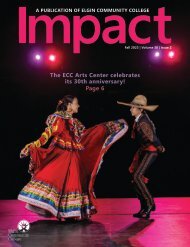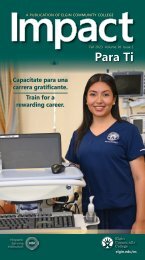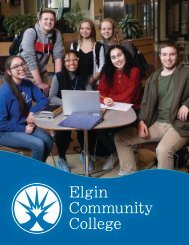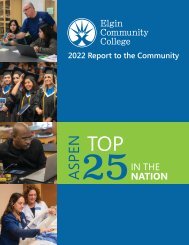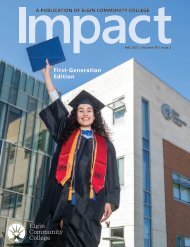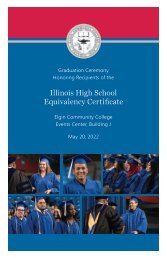ILEA Equity Plan | Elgin Community College (ECC)
There are wide and persistent gaps in college completion rates in Illinois, especially among students of color and low-income students. After an in-depth analysis of our institutional data, Elgin Community College (“ECC” or “the College” or “we” or “our”) has developed an Equity Plan containing annual growth targets for which progress updates will be shared publicly over the next five years. Our Equity Plan reflects the unique characteristics of our institution. For example, ECC is designated as a Hispanic Serving Institution by the US Department of Education, with just over 42% of the students identifying as Latinx or Hispanic. Also, the district served by ECC is widely diverse in terms of income and educational attainment. We will identify the obstacles students face and develop programs and policies that break down unnecessary college graduation barriers. Along with our fellow colleges, in the Partnership for College Completion organization, with this Illinois Equity in Attainment (“ILEA”) plan, we pledge to close the completion gaps by 2025.
There are wide and persistent gaps in college completion rates in Illinois, especially among students of color and low-income students. After an in-depth analysis of our institutional data, Elgin Community College (“ECC” or “the College” or “we” or “our”) has developed an Equity Plan containing annual growth targets for which progress updates will be shared publicly over the next five years. Our Equity Plan reflects the unique characteristics of our institution. For example, ECC is designated as a Hispanic Serving Institution by the US Department of Education, with just over 42% of the students identifying as Latinx or Hispanic. Also, the district served by ECC is widely diverse in terms of income and educational attainment. We will identify the obstacles students face and develop programs and policies that break down unnecessary college graduation barriers. Along with our fellow colleges, in the Partnership for College Completion organization, with this Illinois Equity in Attainment (“ILEA”) plan, we pledge to close the completion gaps by 2025.
Create successful ePaper yourself
Turn your PDF publications into a flip-book with our unique Google optimized e-Paper software.
We believe this strategy will improve equal access to higher education, improve affordability<br />
and decrease debt. Article 26 of the United Nations’ Universal Declaration of Human Rights has<br />
language embedded within it concerning the importance of equal access to higher education. In<br />
our own country, state, and school district, people do not have equal access to higher<br />
education. Higher education is structured in a way that mostly serves to reinforce social<br />
inequality. Of course this issue is broader than just textbooks, but textbooks and school<br />
supplies are an area of costs that do impact affordability and therefore accessibility, and the<br />
cost of which is something that we can work to decrease or remove. The cost of textbooks has<br />
risen 3-4 times the rate of inflation since 1980, according to the Bureau of Labor Statistics<br />
http://www.bls.gov/cpi/. At <strong>ECC</strong>, we estimate it costs students $3,000 in textbooks and<br />
materials to complete an associate’s degree. We estimate that our typical student completes<br />
their degree with just over $3,062 of federal debt. By moving to OER we could make higher<br />
education more accessible and decrease student debt.<br />
Research supports a positive impact on Federal Pell Grant recipient student performance. In a<br />
study of 21,822 students, “OER improve[d] end-of-course grades and decrease[d] DFW (D, F,<br />
and Withdrawal letter grades) rates for all students. They also improve[d] course grades at<br />
greater rates and decrease[d] DFW rates at greater rates for Pell recipient students, part-time<br />
students, and populations historically underserved by higher education.” (Colvard, Watson &<br />
Park, 2018). The study results also demonstrated a narrowing in the gap in academic<br />
performance between white and non-white student groups following OER adoption.<br />
To successfully implement OER, faculty are provided support from librarians, the copyright<br />
officer, and instructional technology/distance learning coordinators. A stipend will likely be<br />
determined to financially support the development efforts of those research and implement<br />
OER material for their coursework. This strategy was first proposed in the Fall 2019. A<br />
committee has been formed to design and implement a pilot program and faculty members will<br />
be solicited to join that pilot.<br />
The OER strategy is connected to other institutional efforts and supports <strong>ECC</strong>’s strategies in our<br />
2018-2022 Strategic <strong>Plan</strong>. See Table 9 for specific strategies that are aligned.<br />
The Success Indicators used to demonstrate this strategy is having an impact are:<br />
• Student completion of course and programs<br />
• Student progression through coursework<br />
• Transfer to subsequent educational<br />
• Student engagement and satisfaction with college programs and services<br />
• Student mastery of learning outcomes<br />
• Enrollment of identified target populations<br />
<strong>ILEA</strong> EQUITY PLAN STRATEGY 3: MENTORING<br />
Mentoring programs, in general, offer a structured forum for students to build relationships;<br />
openly discuss concerns and issues; be connected to valuable resources; make meaningful<br />
34<br />
<strong>ILEA</strong> <strong>Equity</strong> <strong>Plan</strong><br />
Institutional Strategies





